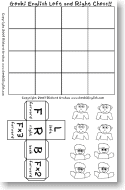🧠 The Beginners Guide On How To Teach English To Humans
It’s crazy that over 66,000 teachers have watched this training on Faceboo...
Review all the English from the previous lessons i.e. Genki Disco Warm Up, Rock, Paper, Scissors, What’s your name?, How are you? and do the Superhero song.
Facing away from the kids, teach them the words left, right, forward and back.
Ninja Tip: Get one of your students to be your partner. Pretend that they are a robot who only understands English and you have to move them around the class using left, right, forward and back commands 🙂
Then using the mini lesson from the Teacher’s Set teach how to sing the song and finally play the animation out loud.
See it in action here with my students:
Or John’s fantastic kindergarten kids in China:
Two game options for you today and both of them rely on real communication.

The first one just needs a blindfold, the Mr Bump Game.

And the second is the Star Wars Lightsaber Battle Game. A little more prep but well worth it!
“Left and Right”
by Richard Graham
Left and right,
Forward and back.
Left and right,
Forward and back.
Left and right,
Forward and back.
Left and right,
Forward and back.
Sit down
Stand up
Turn left
Turn right
And jump, jump,
Jump, jump, jump!
Left and right,
Forward and back.
Left and right,
Forward and back.
Left and right,
Forward and back.
Left and right,
Forward and back.
Spin around
Sit down
Stand up
Spin around
And jump, jump,
Jump, jump, jump
Left and right,
Forward and back.
Left and right,
Forward and back.
Left and right,
Forward and back.
Left and right,
Forward and back.
If you have the Teacher’s Set you can also download these extra printables

Left and Right Chess is a great game to practise directions. The game is played by 2 people. Each person cuts out their four counters and places them on the 4 squares nearest them. One person has Mr Monkey counters, one person has other counters. Then you cut out the dice, fold the faces and stick glue onto the tabs. The players take it in turns to roll the dice and then move one piece one space in the corresponding direction! The “forward x 2” face means you can move one piece either 1 or 2 places, “forward x 3” means you can move one piece 1,2 or 3 places. Obviously you cannot start until you have scored a “forward”. The trick is that you cannot move until you say, in English, the direction you are moving in! You receive one point for every counter that reaches the far side – this counter is then removed from the game. However, if you can move your counter over the top of an opponent’s counter then you capture it, and it’s taken out of the game! If you get a “forward x2” or “forwardx3” and there are no more spaces left, then you stop at the edge of the board and have scored your point. You cannot “Jump” over an opponent, if they get in your way you remove their piece from the board and your piece replaces theirs. The winner is the person with the most points when all the pieces have been removed from the board. You could also try the “speed version” and the person is the winner who has the most points at the end of a certain time!
If you want to see what it really feels like for students learning this way, try learning some Japanese with the version below!
You must be logged in to post a comment.
I might start learning Japanese after this super catchy song 🙂
absolutely fantastic. I feel like learning Japanese …..
Wow !! Thank you so very much for all this exciting and engaging content. You literally saved my sanity. I was having a very hard time with discipline but now but your materials have helped keep the students more focused and interested.
This looks very exciting.I can’t wait to try it with my students. I believe they are going to LOVE it!
I’ve done teh left and right dance with five years old children and they really enjoy this sort of activity. After a few lessons they have become confident with the movements! This morning one little boy took both hands of a girl and they began dancing together as older couples normally do! It was similar to a polka dance! They were so sweet!